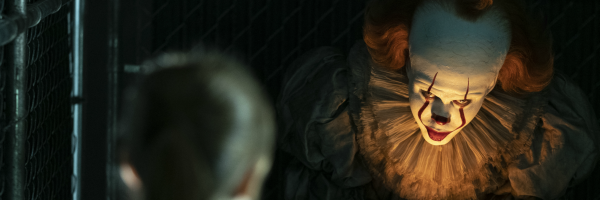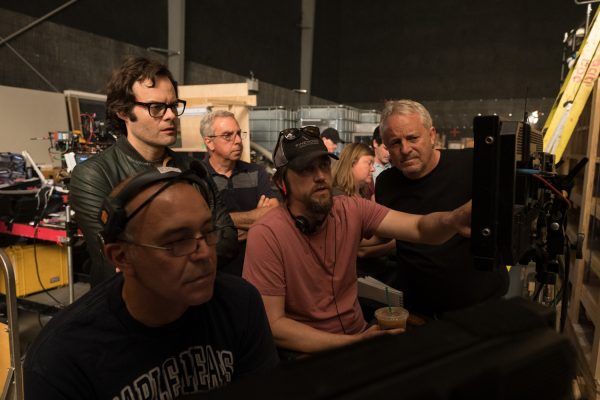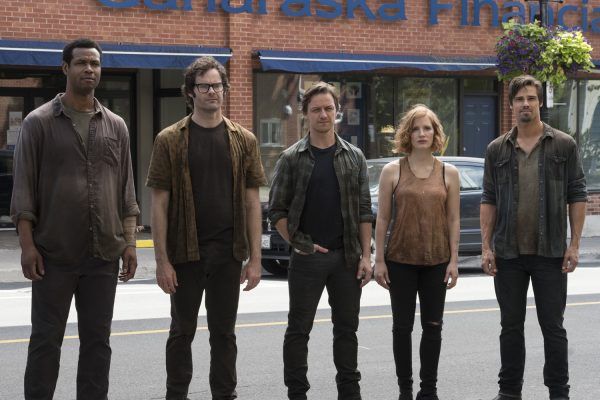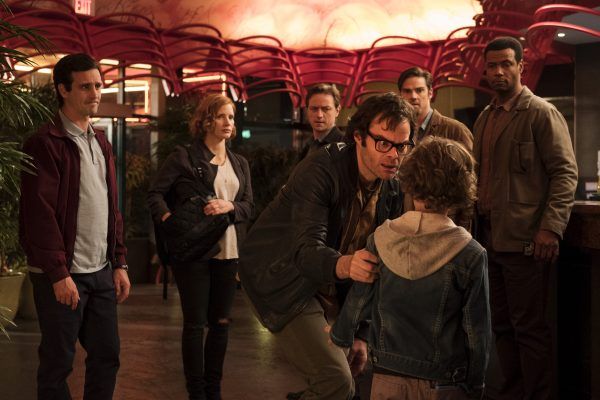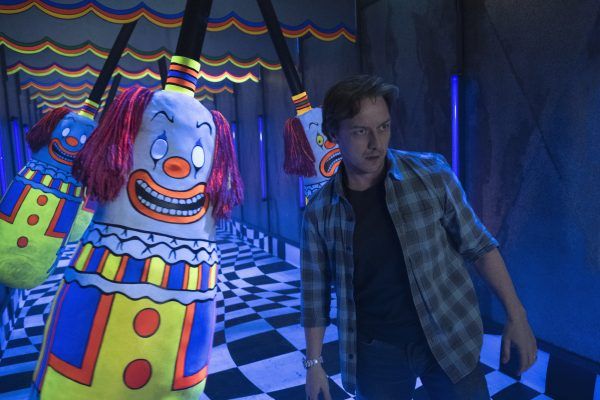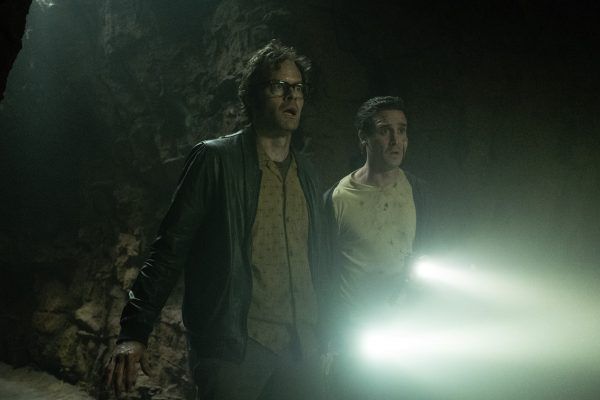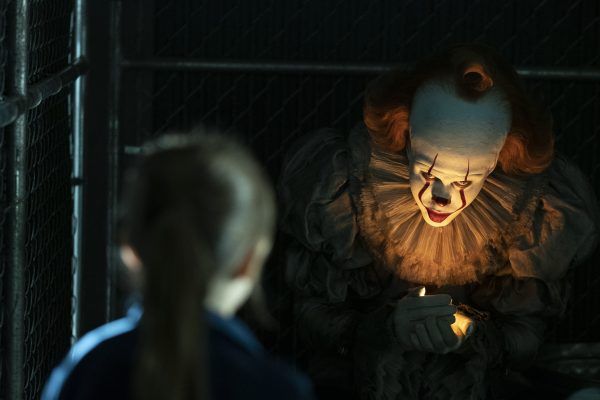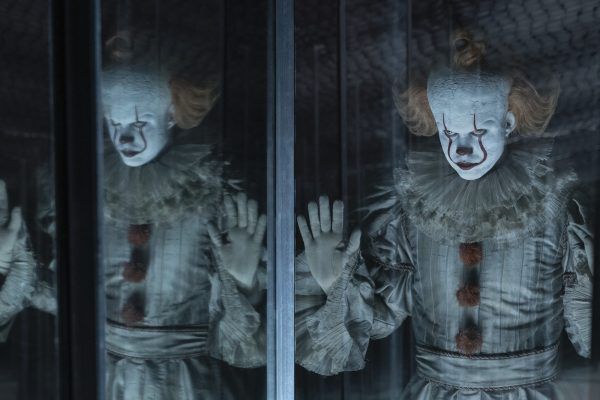It: Chapter Two is a big movie. Not just in terms of running time, but in terms of narrative scope. It bridges a gap between scenes set in the 1980s with an ensemble of young actors and scenes set in present day, with an entirely different adult cast. On top of that you have Bill Skarsgard’s iconic villain Pennywise, who takes many forms as he terrorizes the Losers’ Club in two different time periods. And if you ask the film’s cinematographer Checco Varese what it was like to shoot a film as complex and massive as this, he compares it to climbing Mount Everest five times a week.
Varese took over from It: Chapter One cinematographer Chung-hoon Chung on the sequel, having previously worked with director Andy Muschietti on the scuttled pilot for Locke & Key. For Chapter Two, however, Varese had to straddle two different time periods while also bringing the contemporary scenes to life in a way that reflected the adult fears of the characters. The result is a darker, more sinister-looking film with a number of memorable, dynamic sequences.
I recently got the chance to speak with Varese about his work on It 2, and he discussed the process by which he and Muschietti work together while also talking about the challenge of bringing two different time periods to life. He also talked about how he pulled off that terrific funhouse sequence, discussed the massive practical set built for the Ritual of Chüd finale, and revealed how two major lighting aspects of the film—the firefly scene and the deadlights—were pulled off in camera. It’s an enlightening conversation as Varese doesn’t shy away from the challenges he faced in bringing It: Chapter Two to life, but it’s a testament to the experience and Muschietti's talent that at the end of the day, Varese wouldn’t hesitate to climb Mount Everest with the director again tomorrow.
Check out the full interview below, and for even more of Collider’s coverage on It: Chapter Two click here.
So I saw the film and it looked very daunting. It looked like this was probably a really tough shoot. There were a lot of locations, two huge casts, a lot of things going on…
CHECCO VARESE: Oh man, it was. You climb Mount Everest on Monday, you get to the top of Everest on Monday, and by Friday, you have climbed it five times, and the only thing left is to climb it again the next Monday.
That sounds rough. I'm curious, going back to the beginning, what were your initial conversations with Andy like about what the film would look like, and was there an inkling at that point that this was going to be as tough as it was?
VARESE: Well, Andy's a very special director. He has a movie in his mind and in his soul and the tip of his fingers. He was working for a long time with the illustrators and with the art department, with [production designer] Paul Austerberry, and so he's developed a whole language of color, of texture, of darkness of the way it would look. So it was basically more like a walk to the art department with me and showing me what he thought it would be. And then sort of from there elaborating in more specific colors and textures. He was not like the traditional, let's sit down and read the script. It was more let's go to what I think it looks like and then let me hear what you think.
So were there conversations about the first film and what Chung Hoon-chung had done on that? Was there anything Andy wanted done differently this time around to kind of denote the time change or even just a change in style of shooting?
VARESE: Well, It Chapter Two, it's basically two movies. One movie deals with the past tense and whatever you have to do to make sure the audience understands you're looking at 27 years ago. And I was very specific because one of the things Andy was very meticulous about was to make sure that suspension of disbelief that we were looking or we were witnessing this infamous and now famous summer of the Losers’ Club would make the audience feel they were there. So, that was one part and we had to deal with making it as seamless as possible. It had to look like if they would have shot it or if we were witnessing the event as it happened. So the first movie, which was brilliant, shot by Chung Hoon, was shot with anamorphic.
Andy had some mixed feelings about the anamorphics themselves, not about the movie obviously. He loved the movie, but the anamorphics themselves. So it was in this contemporary movie we wanted to shoot sphericals for the present tense with the older Losers’ Club and a version of anamorphic for the past tense. So instead of jumping back and forth from an anamorphic to non-anamorphic, which would have created a sort of conflict, we used a new set of lenses by Hawk, which they're called The Hybrid. So it's everything you would love from anamorphic except for the fact that they're not anamorphic. And the lens was designed two years ago, so they're very, very beautiful, very sharp, and they have a bokeh that is the anamorphic bokeh. So we were very careful at duplicating or honoring It Chapter One down to the lens size and the location and the wardrobe and so forth and so on.
The second part or the contemporary part was a little bit more of a free ride. It was based on our conversation. That had a little bit more of my knowledge, my signature, my past, my soul in there. It's a darker movie. It's less playful, deals with the fears of the adults. Therefore it's more deeply rooted in paranoia and in any scares that are the adult scares. Therefore it's less, I wouldn't say playful but it's less juvenile or less a kid-like.
Kind of speaking to that, one of my favorite aspects of this film are the transitions between the adults and the kids. And you have scenes where it looks like you probably have Finn Wolfhard and Bill Hader on set at the same time. So the camera moves left and you go right into the younger version of the character. I was wondering if you could kind of talk about those, cause that was a really, really smart decision on your guys' part.
VARESE: I have to say Andy had all the transitions in his head and sometimes we knew about them and sometimes we—we meaning the rest of us, the mortals, the ones that were not in Olympus—the rest of us had a hand in them. But at the end of the day with the brilliancy of Jason Ballantine, the editor, the transitions are extraordinary. I got pleasantly surprised and in awe about some of them. They were brilliant. Some of them I knew and they were designed and some of them they were in Andy's head.
Oh, interesting. So some of them were created in post-production then?
VARESE: Well, I think they all were created in Andy's storyboards in Andy's head. But some of them were really like, there's one in particular where Ben falls into what he built 27 years ago, the Losers’ Club clubhouse. So the camera tilts down with him and then when he tilts up, we see what we think is the Losers coming down and we realize it's the younger ones. That was a very specific camera shot. We were on a stage. We had the Losers’ Club, the underground build. And then we came back two weeks later, we put the camera in the same place with the same lens. We matched the frame and we built down with the new losers and basically a different set. So that was a very specific one. But there are others where he nodded his head and he would just talk to the operator, Angelo Colavecchia and say now you do tilt up and then two weeks later Andy would say now tilt down from this and then they will blend in later. We had all the ingredients on the kitchen countertop and Andy just picked the ones that he wanted to make the plate with.
This is obviously a massive cast and I know how difficult that is to capture as a cinematographer, especially when everyone has dialogue in a scene. What was it like shooting the scenes with al the characters, specifically the Jade of the Orient sequence, which is this round table that just seems like it was probably a nightmare to try and shoot.
VARESE: Oh my God, where do I start? The movie is based on a book that is one of the masterpieces of one of the most talented and read and brilliant writers of this century and last century, at least in North America. I remember when I got the movie, I ordered the book and the box that looked like a milk crate with like seven pounds of stuff inside showed up. And I'm like, what is this? I grew up in South America, so I read A Hundred Years of Solitude. I didn't read It. So when I saw it, I'm like, "Oh my God. This is huge." And so was the movie, so even imagine there's six or seven Losers’ Club young, then there's another six or seven Losers’ Club adult, then there's Pennywise and then there's the cousin, and then there is the grandmother and then there is the father. So you're talking about 18 people that they all talk at the same time. And you have to pay homage to their arcs, their stories, their feelings.
In the Jade of the Orient, we have six of them and the arc of that scene is brutal. It starts with, “I don't want to be here. I'm fearful. I don't remember. Oh my God, I remember. Oh my God, this is so much fun. Oh my God, we love each other and it's wonderful and I'm teasing you and you're teasing me. And then, Oh my God, I'm really afraid of that. So, the arc, it's a movie in itself. And that was extremely difficult, but yet a lot of fun.
There was a feeling of companionship and there was a feeling of being a team. It almost felt like the locker room before a game in soccer or volleyball or basketball though they all were rooting for each other. So that was a lot of fun. But at the same time, everyone needs their pay off. Everyone needs their close up and everyone needs their special moment. And Andy's relentless in interest of the frame itself and how to frame it and what is in the background. He's very tactile. He almost touches the frame every time he corrects something. I think he wishes he could touch the monitor so he could move the flower pot to the left as opposed to standing up and moving it himself.
Yeah. I heard he likes to do a lot of takes.
VARESE: Yes and no. I don't think it's Eyes Wide Shut. Let's put it that way.
It's not Kubrick.
VARESE: I don't think he's Kubrick. But, he's very unpredictable also because he sees the movie in his head. So you may shoot the master 10, 12 times and then you may end up doing a close up once. Because he got the performance in the master and he got what he needed in the master and then he will push in a close up and that will be it. So he's very unpredictable. I wouldn't say he shoots a lot though. I think he shoots enough to do a masterpiece. And that's all I care.
One of my favorite sequences in the film, and one that I'm sure was tricky for you to shoot, is the fun house sequence with all the mirrors where James McAvoy's character is trying to save this kid from Pennywise. I was wondering if you could kind of talk about the construction of that sequence and the execution of it.
VARESE: I have two favorite scenes in the movie—although I love the whole thing—and that’s one of my favorite scenes. The genesis of the scenes was very interesting because we started talking about a funhouse. So what do you have in a funhouse? There were several incarnations of what we should do, and Andy mentioned a house of mirrors and contradicting every instinct that a cinematographer should have, I stand up in the meeting, and said, "Yes. Yes. Let's do a house of mirrors!" And as soon as I finish the sentence, I'm like, Oh my God, what have I done to myself?
And then with the art department and Nigel, which was the art director, he took ownership of that in pride and he created together with me this model to scale of little mirrors, the size of a deodorant, so it's like probably a 10% scale, literally little mirrors and we bought like a lipstick camera of some sort. It was taped to a pencil and we would create these little moves in this little house of mirrors, trying to figure out where we could go where you couldn’t see the camera. And we spent a weekend there moving the mirror to the left. Oh my God, I don't see it. Oh Jesus. And now I see 25 cameras. We we literally created that and then they transposed that into a big house of mirrors, which each mirror was on a gimbal so it could move a little bit.
And then I came up with the idea of doing some of them as two-way mirrors so I could hide the cameras behind the mirrors as if there were no mirrors. I’m very proud to say that I don't know the exact number, but out of the two or three minute scene, I think I saw the camera three times or two times or something like that. So that was very exciting and it was very, very technically challenging.
That's really cool. I mean it came off great. I think it looks fantastic and I really loved the lighting in that sequence as well. I think it's just really dynamic.
VARESE: Yeah, that was very tricky because also you have to hide all your sources from a house of mirrors, you know that you can see everything, so it was very cleverly executed and I think it works out very well because it's very deceiving what you can see.
I kind of wanted to ask about the big finale and shooting in that cave and the Ritual of Chüd and all of that stuff. But specifically just kind of like you spent a lot of time in this cave at the end of the film and so from your perspective, how do you work to keep the frame dynamic? How do you work to keep everyone in their geographic location so the audience understands where Pennywise is and where the characters are and stuff like that?
VARESE: It was the other Everest. That was the opposite of an Everest. We were climbing down the Mariana Trench every morning and swimming up every morning holding your breath. The main concept was let's create as much as possible for real. Let's build a set by which the actors and ourselves could understand where we are. So we had a big stage, one of the largest stages we had available probably the largest one and the art department built walls that rose up to the gills of the stage. There was no space. People were hanging out outside of the stage. There was literally no space to hang out.
We had another stage to just put the gear in video village and things like that. I can't remember the exact measurement but were 150 or 200 feet long by 80 feet wide and the stage was 36 feet high and I think the walls were out to 30 feet. Literally, you could touch a wall with a light. Andy was walking through there at night or on the weekend with the other departments and saying a little more green here, a little more red there, and a little more of this and a little shine. So it was a very tactile process. Because of production reasons, we had a little time to do it correctly and that's what makes the scene work because they are in the real space.
So everybody knew, “Oh, I run there and then I'm coming from here.” There wasn't the usual, “Don't worry, we'll cheat it.” It was very specific the way it was done. And then we had a lot of help from special effects, visual effects, obviously due to the characteristic of the incarnation of Pennywise, even though the movie has come out two weeks ago, I'm not going to go into many details of that. But Bill Skarsgard, I have to say, is a wonderful companion in this trip and an extraordinary actor. And he basically was with us in person throughout some of it. Some other parts he couldn't be there. When Pennywise talks to the actors, it’s actually Bill on some kind of a microphone talking to the actress and interacting in a real-time manner, so that freshness and that improvisation of the dialogue or the screens were happening in real time, even though he was not in person because Pennywise is incarnated in this creature that could not be Bill, but he was there. So I think that gave a lot of confidence and freshness to the performance.
Yeah, his performance is great. What was it like working with Bill and working with Pennywise in this film? And what was it like as a cinematographer just to shoot Pennywise?
VARESE: Yeah. First of all, I think the creation of Pennywise or this incarnation of Pennywise, it's a very handcrafted. It's almost like an artist in the 12th century between Andy and Bill Skarsgard and the makeup effects and the prosthetics. They took advantage of Bill Skarsgard's features and his performance to create a face that belongs to Pennywise but it belongs to Bill as much as it belongs to Pennywise. That's one thing. The other thing is Bill is very aware of lighting so he would move his head a quarter of an inch to the right or to the left or below and look at me and ask me or ask Andy specifically, "Andy, how does it look?" Then Andy would say, "Well, a little lower and take the eyes a little higher. Oh perfect. Perfect." There's a specific scene at the beginning of the movie where the little girl is in a baseball match and she follows a firefly and then she finally encounters Pennywise in a dark corner and something horrible happens. In the camera test, I found that scene fascinating. So when I wanted to test the makeup and et cetera I said to Andy, why don't we test that scene?
We got a little black box and we gave Pennywise a little tiny, tiny, tiny LED light that was in his white glove. And then he would close the hands in a very gentle manner and then open the hands and the light will start shining and pulsing. And that light will literally light Pennywise's face. It was very organic. It was like if it were done with a candlelight or something, just the 21st century. Then we went into research of the color of fireflies and, with the help of the internet, we found out there are some fireflies that are green. Some fireflies are blue, and some fireflies are yellow, orange. A characteristic of that area of the world and during that time of the year, those fireflies would be there. So we picked that sort of yellow, orange color and went with that.
That was done almost entirely in camera. Nothing is done in camera anymore because everything has a little bit of a color correction, a little bit of visual effects. But 99% [of that scene] was done in camera. It's Bill Skarsgard with his makeup and his prosthetics and his talent and the talent of my gaffer and a dimmer with a little LED light and the serendipity of me thinking of an LED in his hand. It was very rewarding and at the same time when you go into the big incarnation of Pennywise, like in any creature movie, there is the guy with a big stick and a tennis ball at the end. So everybody looks at the same point. But Bill was doing motion-capture with four cameras and the whole performance of that part of the movie, it's Bill's face. Oversized and with tweaks and visual effects, but it's Bill's face. It's the size of a CG character, but the actual expressions and performance is Bill's expressions and performance. So I would say it's like a 1950s movie done in 2018.
That firefly sequence is one of my favorite sequences of the film as well. I thought that was just really beautiful.
VARESE: Yeah, because it's also very tender and he's very sweet.
This is already a very long movie, but I was wondering if there were any memorable deleted scenes that you remember. I know Andy's working on a supercut of both films together right now that presumably will maybe include some extra stuff, but was there anything particularly noteworthy that you can remember that didn't make it in?
VARESE: Yes and no. I tend to remember the movies once they're finished. There is a whole sequence in the memories of the Losers’ Club when they are searching for the tokens. There is a sequence in that of Mike going back to his house when it's burning or about to burn or already burned. And then there is a whole very complex sequence that we shot that didn't make the movie and I'm looking forward for the cut of that because it's a wonderful scene and it's very, very tender and very sweet and at the same time is very scary. We should wait for Andy to cut the supercut and see what that is.
Yeah. I was hoping to see a flashback with Mike, so it's nice to know that you guys shot one I'm sure fans will be excited to see that.
VARESE: Yeah we shot one and it's super beautiful. Mike is a very lovable character throughout so I think the audience will have a wonderful time seeing what he remembers of that moment. There is a little hint in the movie right now when there's a little baby Mike looking at some wall on fire. But that's a very brief moment. It does develop into a complex scene that I'm looking forward to watching.
But in terms of difficult sequences, talking about the Ritual of Chüd, that was extremely technically challenging because when you see the movie there is this orb the deadlights coming down the sky from the ceiling of the cavern. The technical part of it was very interesting because one of the things that is very tricky in visual effects is to recreate how light affects faces or how light effects environment. Especially the direction of light, if your shadow is your shadow, your shadow is your shadow. Of course you can replicate it and recreate it, but that's very time consuming, expensive, and if you can do it practically, it's better. So there was this whole theory of dropping a light from the ceiling of the stage, which is, as I said, 40 feet above our heads and very precisely in a precise movement that can be repeatable down to the frame. We had to drop an array of LEDs into the urn. That took a lot of science between special effects, stunts, and a stunt rig. It's almost like a super sophisticated crane that drops the weight in a ship.
We were dropping this little LED array that had to fit, and the LED array was let's say six inches wide and the urn was six inches and a half wide so the clearance was non-existent and we literally dropped this light 40 feet so it created the shadows and it was pulsating at a certain rhythm that Andy was giving by tapping the shoulder of my gaffer with his finger as if he was listening to the music that will play eventually, the heartbeat of Pennywise. And the light would blink at the same speed or the same cadence and this little array of LEDs ended up inside the urn and I remember jumping. I was watching. I remember jumping as if my team had just scored a goal in futbol. I was rooting as if I were in a stadium because we achieved an extremely, extremely sophisticated technical achievement that at the end of the day in the movie, everybody thinks it's a visual effect. But it was actually done in camera. Obviously we erased the actual LED and we turn it into this rotating globes, but the actual device that created the light was done practically. That was fascinating.
That's really impressive. Well congrats for getting to the finish line. I knew instantly how hard this movie must have been to shoot as I was watching it.
VARESE: Thank you so much. And that the last words I’ll say is if Andy would ask me to climb the Everest tomorrow morning, I would gladly do so again.
It: Chapter Two is now playing in theaters.

